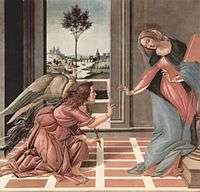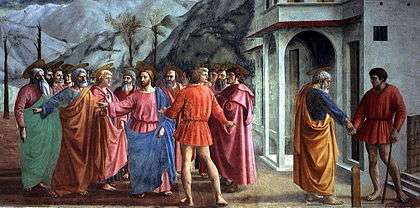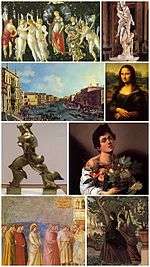Quattrocento

The cultural and artistic events of 15th-century Italy are collectively referred to as the Quattrocento (Italian pronunciation: [ˌkwattroˈtʃɛnto]) from the Italian for the number 400, in turn from millequattrocento, 1400, the year that ended the 14th century. Quattrocento encompasses the artistic styles of the late Middle Ages (most notably International Gothic) and the early Renaissance.
Historical context

After the decline of the Western Roman Empire in 476, economic disorder and disruption of trade spread across Europe. This was the beginning of the Early Middle Ages, which lasted roughly until the 11th century, when trade picked up, population began to expand and the papacy regained its authority.
In the late Middle Ages, the political structure of the European continent slowly evolved from small, highly unstable fiefdoms into larger nation states ruled by monarchies, thereby providing greater stability. In Italy, urban centers arose that were populated by merchant and trade classes, who were able to defend themselves. Money replaced land as the medium of exchange, and increasing numbers of serfs became freedmen. The changes in Medieval Italy and the decline of feudalism paved the way for social, cultural, and economic changes.
The Quattrocento is viewed as the transition from the Medieval period to the age of the Renaissance, principally in the cities of Rome, Florence, Milan, Venice and Naples.
Development of Quattrocento styles
Quattrocento art shed the decorative mosaics typically associated with Byzantine art along with the Christian and Gothic media of and styles in stained glass, frescoes, illuminated manuscripts and sculpture. Instead, Quattrocento artists and sculptors incorporated the more classic forms developed by Roman and Greek sculptors.
List of Italian Quattrocento artists
Since the Quattrocento overlaps with part of the Renaissance movement, it would be inaccurate to say that a particular artist was Quattrocento or Renaissance. Artists of the time probably would not have identified themselves as members of a movement.
- Andrea del Castagno
- Andrea del Verrocchio
- Andrea della Robbia
- Andrea Mantegna
- Antonello da Messina
- Antoniazzo Romano
- Antonio Pollaiuolo
- Antonio Rossellino
- Benozzo Gozzoli
- Bertoldo di Giovanni
- Carlo Crivelli
- Cosimo Tura
- Desiderio da Settignano
- Domenico di Bartolo
- Domenico Ghirlandaio
- Domenico Veneziano
- Donatello
- Ercole de' Roberti
- Filippo Brunelleschi
- Filippo Lippi
- Fra Angelico
- Francesco del Cossa
- Francesco di Giorgio
- Francesco Squarcione
- Gentile Bellini
- Gentile da Fabriano
- Giovanni Bellini
- Giovanni di Paolo
- Jacopo Bellini
- Justus of Ghent
- Leonardo da Vinci
- Lorenzo Ghiberti
- Luca della Robbia
- Luca Signorelli
- Luciano Laurana
- Masaccio
- Masolino
- Melozzo da Forlì
- Michelangelo di Lodovico Buonarroti Simoni
- Paolo Uccello
- Pedro Berruguete
- Piero della Francesca
- Pietro Perugino
- Sandro Botticelli
- Il Sassetta
- Vecchietta
- Vittore Carpaccio
- Vittore Crivelli
Also see the list of 27 prominent 15th century painters made contemporaneously by Giovanni Santi, Raphael Sanzio's father as part of a poem for the Duke of Urbino.
See also
- Trecento, the 14th century in Italian culture
- Cinquecento, the 16th century in Italian culture
- Seicento, the 17th century in Italian culture
- Settecento, the 18th century in Italian culture
References
- Pope-Hennessy, John & Kanter, Laurence B. (1987). The Robert Lehman Collection I, Italian Paintings. New York, Princeton: The Metropolitan Museum of Art in association with Princeton University Press. ISBN 0870994794. (see table of contents)
External links
| Look up quattrocento in Wiktionary, the free dictionary. |

